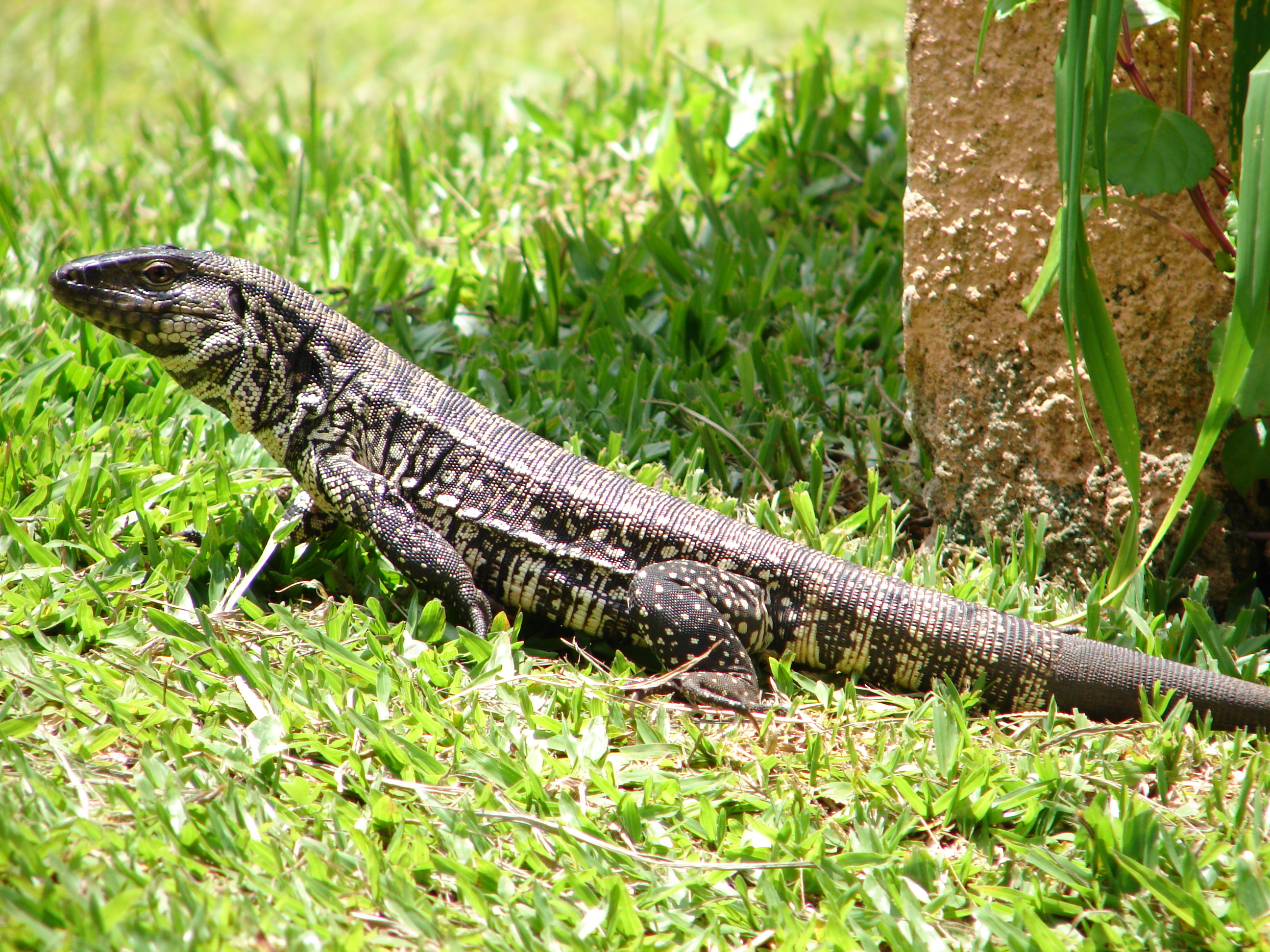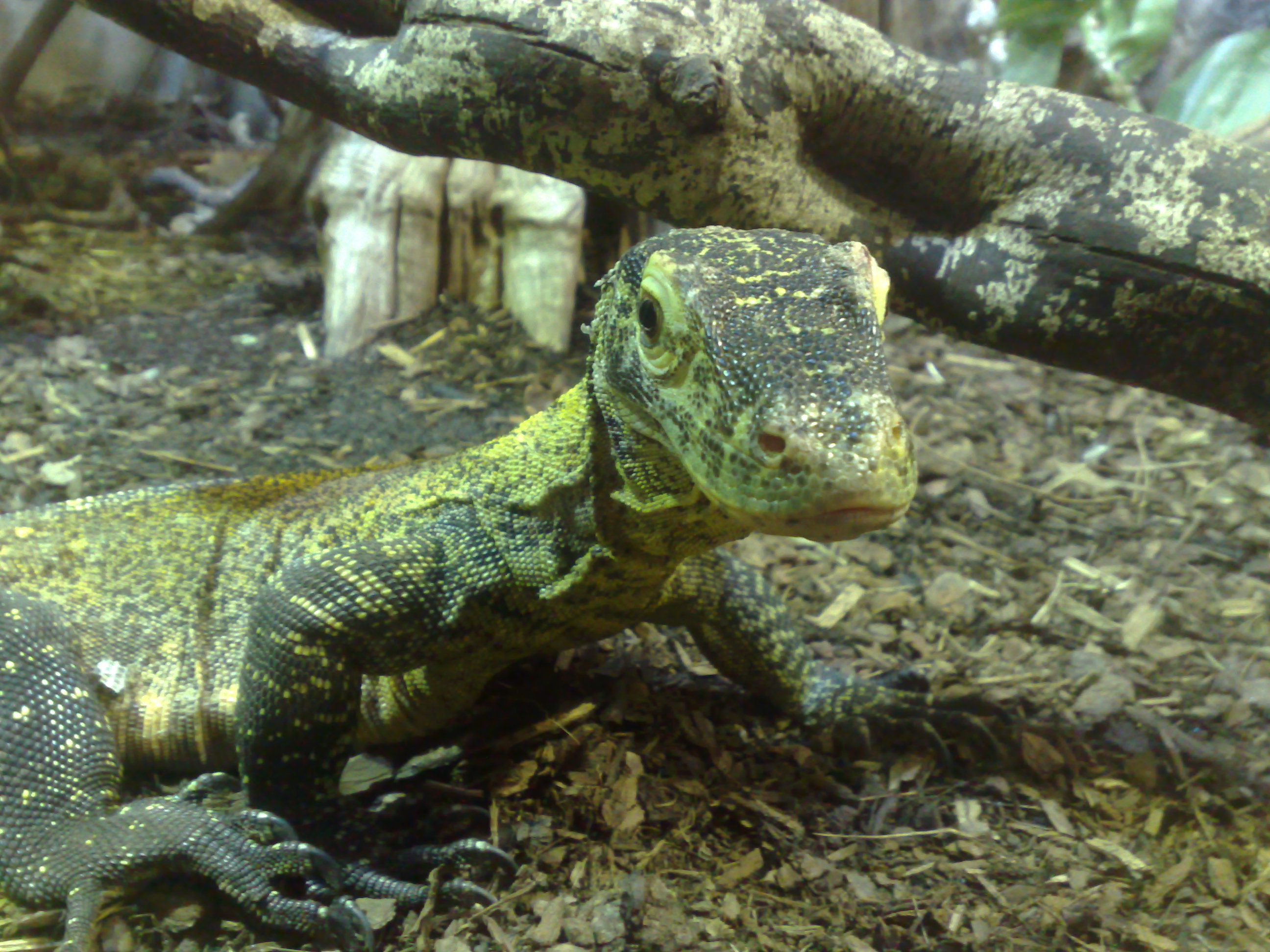|
Teiidae
Teiidae is a family of autarchoglossan lizards native to the Americas. Members of this family are generally known as whiptails or racerunners; however, tegus also belong to this family. Teiidae is sister to the Gymnopthalmidae, and both families comprise the Teiioidea. The Teiidae includes several parthenogenic species – a mode of clonal reproduction. Presently, the Teiidae consists of approximately 150 species in eighteen genera. Morphology and behavior Teiids can be distinguished from other lizards by the following characteristics: they have large rectangular scales that form distinct transverse rows ventrally and generally small granular scales dorsally, they have head scales that are separate from the skull bones, and the teiid teeth are solid at the base and "glued" to the jaw bones. Additionally, all teiids have a forked, snake-like tongue. They all possess well-developed limbs. Teiids are all terrestrial (few are semi-aquatic) and diurnal, and are primarily carnivor ... [...More Info...] [...Related Items...] OR: [Wikipedia] [Google] [Baidu] |
Tegu
Tegu is a common name of a number of species of lizards that belong to the families Teiidae and Gymnophthalmidae. Tegus are native to Central and South America. They occupy a variety of habitats and are known for their large size and predatory habits. Description Tegus are usually mainly black and some have yellow, reddish or white bands along their backs. Others have lines going down their bodies and unique markings along their top. Their body shape is aerodynamic with long tails and strong legs. Most tegus grow to about a metre long but the black and white tegu (''T. Merianae'') can grow to about 1.3 metres. Tegus use their tongues and vomeronasal organ to find chemical cues associated with their prey and other lizards. A vomeronasal organ is an organ of chemoreception located in the main nasal chamber. Tegus can survive in rainforests, savannas, swamps, meadows, and open fields. Tegus are omnivores and eats seeds, berries, fruits, small rodents, insects, eggs, amphibians, ... [...More Info...] [...Related Items...] OR: [Wikipedia] [Google] [Baidu] |
Squamata
Squamata (, Latin ''squamatus'', 'scaly, having scales') is the largest order of reptiles, comprising lizards, snakes, and amphisbaenians (worm lizards), which are collectively known as squamates or scaled reptiles. With over 10,900 species, it is also the second-largest order of extant (living) vertebrates, after the perciform fish. Members of the order are distinguished by their skins, which bear horny scales or shields, and must periodically engage in molting. They also possess movable quadrate bones, making possible movement of the upper jaw relative to the neurocranium. This is particularly visible in snakes, which are able to open their mouths very wide to accommodate comparatively large prey. Squamata is the most variably sized order of reptiles, ranging from the dwarf gecko (''Sphaerodactylus ariasae'') to the Reticulated python (''Malayopython reticulatus'') and the now-extinct mosasaurs, which reached lengths over . Among other reptiles, squamates are most close ... [...More Info...] [...Related Items...] OR: [Wikipedia] [Google] [Baidu] |
Ameiva
''Ameiva'', commonly called jungle-runners, is a genus of whiptail lizards that belongs to the family Teiidae. Geographic range Member species of the genus ''Ameiva'' are found in South America, Central America and the Caribbean (West Indies). Their major habitat in four regions of Brazil include: Caatinga, Cerrado, the Amazonian rain forest, and the Amazonian savanna. Additionally, ''Ameiva ameiva'' has been introduced to Florida in the United States. Species Sourced from "The Reptile Database". The Reptile Database. http://www.reptile-database.org. '''': A |
Lizard
Lizards are a widespread group of squamate reptiles, with over 7,000 species, ranging across all continents except Antarctica, as well as most oceanic island chains. The group is paraphyletic since it excludes the snakes and Amphisbaenia although some lizards are more closely related to these two excluded groups than they are to other lizards. Lizards range in size from chameleons and geckos a few centimeters long to the 3-meter-long Komodo dragon. Most lizards are quadrupedal, running with a strong side-to-side motion. Some lineages (known as "legless lizards"), have secondarily lost their legs, and have long snake-like bodies. Some such as the forest-dwelling ''Draco'' lizards are able to glide. They are often territorial, the males fighting off other males and signalling, often with bright colours, to attract mates and to intimidate rivals. Lizards are mainly carnivorous, often being sit-and-wait predators; many smaller species eat insects, while the Komodo eats mammals a ... [...More Info...] [...Related Items...] OR: [Wikipedia] [Google] [Baidu] |
Parthenogenesis
Parthenogenesis (; from the Greek grc, παρθένος, translit=parthénos, lit=virgin, label=none + grc, γένεσις, translit=génesis, lit=creation, label=none) is a natural form of asexual reproduction in which growth and development of embryos occur in a gamete (egg or sperm) without combining with another gamete (e.g., egg and sperm fusing). In animals, parthenogenesis means development of an embryo from an unfertilized Gametophyte, egg cell. In plants, parthenogenesis is a component process of apomixis. In algae, parthenogenesis can mean the development of an embryo from either an individual sperm or an individual egg. Parthenogenesis occurs naturally in some plants, algae, invertebrate animal species (including nematodes, some tardigrades, water fleas, some scorpions, aphids, some mites, some bees, some Phasmatodea and parasitic wasps) and a few vertebrates (such as some fish, amphibians, reptiles and birds). This type of reproduction has been induced artificially ... [...More Info...] [...Related Items...] OR: [Wikipedia] [Google] [Baidu] |
New Mexico Whiptail
The New Mexico whiptail (''Aspidoscelis neomexicanus'') is a female-only species of lizard found in the southwestern United States in New Mexico and Arizona, and in northern Mexico in Chihuahua. It is the official state reptile of New Mexico. It is one of many lizard species known to be parthenogenetic. Individuals of the species can be created either through the hybridization of the little striped whiptail ('' A. inornatus'') and the western whiptail ('' A. tigris''), or through the parthenogenetic reproduction of an adult New Mexico whiptail. The hybridization of these species prevents healthy males from forming, whereas males exist in both parent species (see Sexual differentiation). Parthenogenesis allows the resulting all-female population to reproduce and thus evolve into a unique species capable of reproduction. This combination of interspecific hybridization and parthenogenesis exists as a reproductive strategy in several species of whiptail lizard within the genus ''As ... [...More Info...] [...Related Items...] OR: [Wikipedia] [Google] [Baidu] |
Ameivula
''Ameivula'' is a genus of lizard that belongs to the family Teiidae. Many species were previously listed in the genus ''Cnemidophorus ''Cnemidophorus'' is a genus of lizards in the family Teiidae. Species in the genus ''Cnemidophorus'' are commonly referred to as whiptail lizards or racerunners. The genus is endemic to South America, Central America, and the West Indies. Ta ...''. Classification Listed alphabetically. The Reptile Database *'' Ameivula abalosi'' *'' Ameivula apipensis'' *'' [...More Info...] [...Related Items...] OR: [Wikipedia] [Google] [Baidu] |
Parthenogenesis
Parthenogenesis (; from the Greek grc, παρθένος, translit=parthénos, lit=virgin, label=none + grc, γένεσις, translit=génesis, lit=creation, label=none) is a natural form of asexual reproduction in which growth and development of embryos occur in a gamete (egg or sperm) without combining with another gamete (e.g., egg and sperm fusing). In animals, parthenogenesis means development of an embryo from an unfertilized Gametophyte, egg cell. In plants, parthenogenesis is a component process of apomixis. In algae, parthenogenesis can mean the development of an embryo from either an individual sperm or an individual egg. Parthenogenesis occurs naturally in some plants, algae, invertebrate animal species (including nematodes, some tardigrades, water fleas, some scorpions, aphids, some mites, some bees, some Phasmatodea and parasitic wasps) and a few vertebrates (such as some fish, amphibians, reptiles and birds). This type of reproduction has been induced artificially ... [...More Info...] [...Related Items...] OR: [Wikipedia] [Google] [Baidu] |
Gymnophthalmidae
Gymnophthalmidae is a family of lizards with at least 250 species, sometimes known commonly as spectacled lizards or microteiids. They are called "spectacled" because of their transparent lower eyelids, which allow them to still see with closed eyes. As in most lizards, except geckos, these eyelids are movable. The Alopoglossidae have been recently moved from this family. Description and ecology Spectacled lizards are related to the Teiidae, but they look like skinks (slightly more distant relatives) with smooth scales. They are generally small lizards; many species have reduced limbs. Unusually among lizards, however, it is generally the hind limbs that are reduced or absent, rather than the forelimbs. Bauer (1998). Gymnophthalmids live in a wide variety of habitats, from desert to mountain to rain forest, throughout Central America and South America. They are usually inhabitants of the forest floor or wet areas associated with tropical forests, either nocturnal or intermitten ... [...More Info...] [...Related Items...] OR: [Wikipedia] [Google] [Baidu] |
Autarchoglossa
Autarchoglossa is a clade (evolutionary grouping) of squamates that includes skinks, anguimorphs, snakes, and relatives. Autarchoglossa is supported as a monophyletic grouping (i.e. a valid clade) by morphological features in living and extinct lizards and snakes. Some phylogenetic analyses based on molecular features such as DNA sequences in living squamates do not support Autarchoglossa. The recent proposal of the Toxicofera clade places Iguania within Autarchoglossa, which is not supported by morphological analyses. Placing Iguania within Autarchoglossa may lead to confusion as Autarchoglossa means "free-tongued", and iguanians do not have this feature. To circumvent this, it has been proposed that Autarchoglossa be renamed to Unidentata (single egg-tooth, a feature both groups share) and be redefined to include Iguania.Vidal, N. and Hedges, S.B. 2005. The phylogeny of squamate reptiles (lizards, snakes, and amphisbaenians) inferred from nine nuclear protein-coding genes. ''C.R ... [...More Info...] [...Related Items...] OR: [Wikipedia] [Google] [Baidu] |
Cambridge University Press
Cambridge University Press is the university press of the University of Cambridge. Granted letters patent by Henry VIII of England, King Henry VIII in 1534, it is the oldest university press A university press is an academic publishing house specializing in monographs and scholarly journals. Most are nonprofit organizations and an integral component of a large research university. They publish work that has been reviewed by schola ... in the world. It is also the King's Printer. Cambridge University Press is a department of the University of Cambridge and is both an academic and educational publisher. It became part of Cambridge University Press & Assessment, following a merger with Cambridge Assessment in 2021. With a global sales presence, publishing hubs, and offices in more than 40 Country, countries, it publishes over 50,000 titles by authors from over 100 countries. Its publishing includes more than 380 academic journals, monographs, reference works, school and uni ... [...More Info...] [...Related Items...] OR: [Wikipedia] [Google] [Baidu] |
Pseudocopulation
Pseudocopulation describes behaviors similar to copulation that serve a reproductive function for one or both participants but do not involve actual sexual union between the individuals. It is most generally applied to a pollinator attempting to copulate with a flower. Some flowers mimic a potential female mate visually, but the key stimuli are often chemical and tactile. This form of mimicry in plants is called Pouyannian mimicry. Orchids commonly achieve reproduction in this manner, secreting chemicals from glands (osmophores) in the sepals, petals, or labellum, that are indistinguishable from the insect's natural pheromones. The pollinator then has a pollinium attached to its body, which it transfers to the stigma of another flower when it attempts another 'copulation'. Pollinators are often bees, and wasps of the order Hymenoptera, and flies. The cost to the pollinating insects might be seen as negligible, but study of ''Cryptostylis'' (an Australian orchid) pollinators show ... [...More Info...] [...Related Items...] OR: [Wikipedia] [Google] [Baidu] |






